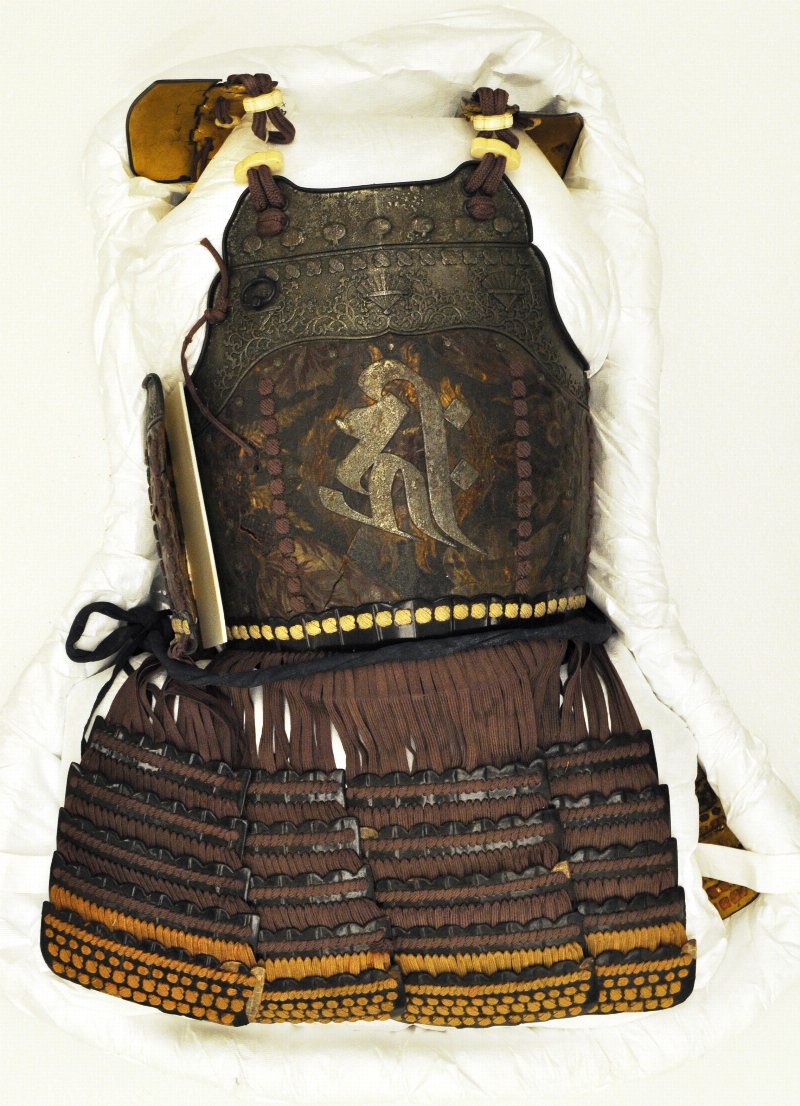| Object Number | A1107B |
| Current Location | Collections Storage |
| Culture | Japanese |
| Provenience | Japan |
| Date Made | 16th Century - 1911 |
| Section | Asian |
| Materials | Metal | Textile |
| Iconography | Monkey | Fan | Ivy | Flowers | Sanskrit Character |
| Inscription Language | Sanskrit |
| Description | A two-section, or clam shell, Western influenced samurai cuirass (ni-mai nanban-do). The cuirass is constructed of a breastplate joining with a similarly constructed back plate. Both the front and back plates have a perimeter of rough, silver metal with a decorative relief of fans, ivy, and cross knot lacing. A metal ring is attached to the right side of the breastplate near the top. The central portion of both plates is wrapped with leather. The leather of the breastplate is embossed with a design of colored leaves and flowers. In the center, there is a relief of a Sanskrit character, ह्रीः (hrīḥ), representing the Buddhist protective diety Amitābha or Amida. The leather of the back plate is embossed with a monkey climbing a tree. A large, orange, decorative bow (agemaki) hangs from a large ring mounted toward the upper end of the cuirass reverse. A hinge on the left side of the cuirass allows it to open and close and a burgundy cord on the right side secures it when worn. The upper-most back plate (boko-no-ita) supports the shoulder straps (watagami) which reach over the shoulders to the front of the cuirass. The upper-most front plate (muna-ita) supports toggles made of ivory which would secure the shoulder straps. This front plate attaches to the breastplate with a hinge. The front plate has a decorative relief of a row of ovals and the same rough, silver appearance as the metal portions of the breastplate. The back plate is similar. The shoulder straps have thick, burgundy cords designed to hold the many movable parts together. Armored plates (kobire or kohire) are attached to the outside of the shoulder straps and serve to protect the area between the cuirass and the shoulder guards. Eight, five lame, pendant-like tassets (gessan) hang from the bottom of the cuirass. Lames get progressively wider as they advance down the gessan. Each rawhide (nerigawa) lame is a strip of wide, humped, "false scales" (kiritsuke yahazu gashira iyozane) to give the appearance of individual scales. Lames are coated with black lacquer. The top four lames are connected to one another with burgundy silk laces in the kebiki-odoshi style. The 4th and 5th lame connect with brown lacing. The lowest lame features a horizontal row of brown lacing over two rows of brown cross knot laces. |
| Credit Line | Purchased from W. O. Oldman, 1911 |
| Other Number | 14602 - Dealer's Number | A1107 - Original Set - Other Number | 88 - Samurai Armor List |
Report problems and issues to digitalmedia@pennmuseum.org.


